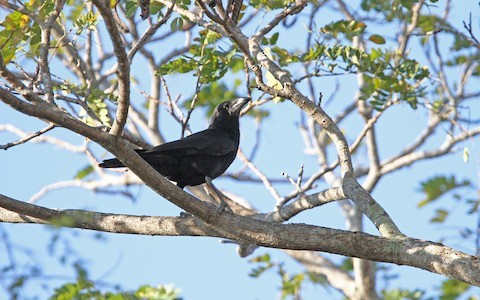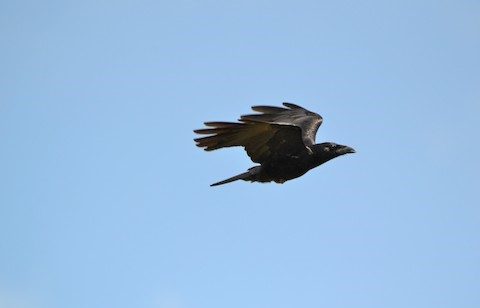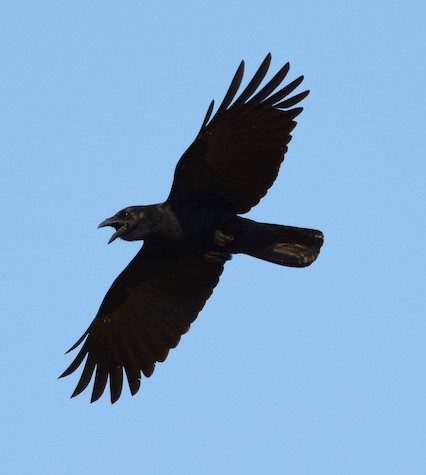Birdfinding.info ⇒ Rare, local, and declining. The best area to find this endangered species is at Rancho La Belén and along the road to that site from Camagüey. It can also be found west of Camagüey along the road to Vertientes and adjacent side roads, and in Sancti Spíritus along the Circuito Sur at Pitajones, Palmarejo, Vaqueria La Concha, and Banao. Cuban Crow occurs throughout the Cuban Palm Crow’s range and is easily confused with it.
Cuban Palm Crow
Corvus minutus
Endemic to Cuba, where it occurs mainly in palm savannas.
Formerly widespread across most of western and central Cuba, but large-scale declines have reduced its range to two remaining strongholds: (1) south-coastal Cienfuegos and southern Sancti Spíritus; and (2) south-central Camagüey.
A third population in Pinar del Río was apparently extirpated in the 1980s or so although several recent sources continue to refer to it.
Identification
Slightly smaller than the commoner Cuban Crow, with a slightly thinner head, neck, and bill, but the two are best distinguished by voice.
Cuban Palm Crow is reportedly far more likely than Cuban Crow to forage on the ground, so this habit may be a useful indicator.

Cuban Palm Crow. (Rancho La Belen, Camagüey, Cuba; February 25, 2016.) © Joshua D. Vandermeulen

Cuban Palm Crow. (Najasa, Camagüey, Cuba; March 3, 2017.) © Jukka Jantunen

Cuban Palm Crow. (Rancho La Belen, Camagüey, Cuba; March 25, 2018.) © Mel Senac

Cuban Palm Crow. (Najasa, Camagüey, Cuba; March 2013.) © Ian Merrill

Cuban Palm Crow. (Najasa, Camagüey, Cuba; February 18, 2005.) © Arthur Grosset

Cuban Palm Crows. (Circuito Sur, Sancti Spíritus, Cuba; April 19, 2017.) © Gera Guzman

Cuban Palm Crow. (Rancho La Belen, Camagüey, Cuba; March 1, 2018.) © Christoph Moning

Cuban Palm Crow. (Vaqueria La Concha, Sancti Spíritus, Cuba; April 12, 2018.) © Kenneth Butler

Cuban Palm Crow. (Circuito Sur, Sancti Spíritus, Cuba; April 14, 2019.) © Michael J. Good

Cuban Palm Crow. (Circuito Sur, Sancti Spíritus, Cuba; April 14, 2019.) © Michael J. Good

Cuban Palm Crow. (Rancho La Belen, Camagüey, Cuba; March 5, 2019.) © Dave Curtis

Cuban Palm Crow. (Vaqueria La Concha, Sancti Spíritus, Cuba; April 12, 2018.) © Kenneth Butler

Cuban Palm Crow. (Circuito Sur, Sancti Spíritus, Cuba; February 28, 2019.) © Arco Huang
Notes
Monotypic species. Traditionally considered conspecific with Hispaniolan Palm Crow, but differences in voice and other characteristics suggest that the two are distinct.
Two Species of Palm Crows. Opinions differ on the taxonomic status of Hispaniolan and Cuban Palm Crows. Raffaele et al. (1998) regard the two as separate species based on differences in voice, plumage sheen, and leg and bill measurements. The Handbook of the Birds of the World regards the two as conspecific, stating that “even as races they are weakly differentiated; vocal differences minor.”
Based on recordings available online, there is an apparent difference between the voices of the two forms. Hispaniolan’s is rougher, more guttural, whereas Cuban’s is higher-pitched, smoother, and more varied. Raffaele et al. also describe a difference in phrasing: Cuban’s as “a harsh craao, with an initial abrupt rise in pitch, then leveling off and falling slightly at the end”; and Hispaniolan’s as “a harsh nasal aaar, with the vowel sound as in the word ‘fast.’”
Raffaele et al. describe the sheens on Cuban’s plumage as “a faint violet” and on Hispaniolan’s as “purplish and bluish”—but this distinction is difficult to parse and it seems more accurate to describe Hispaniolan’s as purplish, bluish, or violet, and Cuban’s as faint-to-nonexistent The two forms also differ ecologically as reflected in their habitat tolerances, with Hispaniolan occurring mainly in pine forests and desert scrub, and Cuban mainly lowland palm savannas.
References
BirdLife International. 2018. Corvus palmarum. The IUCN Red List of Threatened Species 2018: e.T22731517A131548171. http://dx.doi.org/10.2305/IUCN.UK.2018-2.RLTS.T22731517A131548171.en. (Accessed June 25, 2019.)
eBird. 2019. eBird: An online database of bird distribution and abundance. Cornell Lab of Ornithology, Ithaca, N.Y. http://www.ebird.org. (Accessed June 25, 2019.)
Garrido, O.H, and A. Kirkconnell. 2000. Field Guide to the Birds of Cuba. Cornell University Press, Ithaca, N.Y.
Marzluff, J., and C.J. Sharpe. 2017. Palm Crow (Corvus palmarum). In Handbook of the Birds of the World Alive (J. del Hoyo, A. Elliott, J. Sargatal, D.A. Christie and E. de Juana, eds.). Lynx Edicions, Barcelona. https://www.hbw.com/node/60790 . (Accessed June 25, 2019.)
Raffaele, H., J. Wiley, O. Garrido, A. Keith, and J. Raffaele. 1998. A Guide to the Birds of the West Indies. Princeton University Press, Princeton, N.J.
